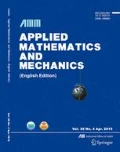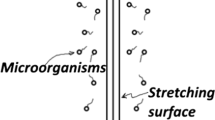Abstract
In this paper, the three-dimensional nanofluid bio-convection near a stagnation attachment is studied. With a set of similarity variables, the governing equations embodying the conservation of total mass, momentum, thermal energy, nanoparticles and microorganisms are reduced to a set of fully coupled nonlinear differential equations. The homotopy analysis method (HAM)-finite difference method (FDM) technique is used to obtain exact solutions. The effect of various physical parameters on distribution of the motile microorganisms and the important physical quantities of practical interests are presented and discussed.
Similar content being viewed by others
Abbreviations
- a :
-
semi-major radii of curvature tangent to stagnation point surface
- b :
-
semi-minor radii of curvature tangent to stagnation point surface
- c :
-
ratio of two principal radii of curvature, c = b/a
- C :
-
nanoparticle volume fraction
- C w :
-
nanoparticle volume fraction at body surface
- C∞:
-
ambient nanofluid volume fraction
- C fx :
-
C fy, local skin friction coefficients along x-and y-directions, respectively
- C fx :
-
C fy, local skin friction coefficients along xand y-directions, respectively
- D B :
-
Brownian diffusion coefficient
- D T :
-
thermophoretic diffusion coefficient
- D m :
-
diffusivity of microorganisms
- g :
-
gravitational acceleration
- g :
-
vector of gravitational acceleration
- Gr :
-
Grashof number
- j :
-
vector of flux of microorganisms
- Le :
-
Lewis number
- N :
-
number density of motile microorganisms
- N w :
-
density of microorganisms at body surface
- N∞:
-
ambient density of microorganisms
- N B :
-
Brownian motion parameter
- N r :
-
bouncy-ratio parameter
- N T :
-
thermophoresis parameter
- Nu x :
-
local Nusselt number
- p :
-
pressure
- Pr :
-
Prandtl number
- Pe :
-
bioconvection Péclet number
- qwC :
-
wall mass flux
- qwN :
-
wall motile microorganism flux
- qwT :
-
wall heat flux
- Qmx,Qmy :
-
local wall flux of nanoparticles along x- and y-directions, respectively
- Qnx,Qny :
-
local wall flux of motile microorganisms along x- and y-directions, respectively
- Ra b :
-
bioconvection Rayleigh number
- Re x ,Re y :
-
local Reynolds numbers along x- and y-directions, respectively
- Sc :
-
Schmidt number
- T :
-
temperature
- T w :
-
temperature at body surface
- T∞:
-
ambient temperature
- u, v, w :
-
velocity components along x-, y- and z-axes, respectively
- v :
-
velocity vector
- ṽ :
-
average swimming velocity vector of gyrotactic microorganisms
- W c :
-
maximum cell swimming speed
- x, y, z :
-
Cartesian coordinates
- ṽ x , ṽ y , ṽ z :
-
average swimming velocities of gyrotactic microorganisms
- α :
-
thermal diffusivity of nanofluid
- β :
-
volumetric volume expansion coefficient
- ν :
-
kinematic viscosity, ν = µ/ρf
- μ:
-
dynamic viscosity
- ρf:
-
nanofluid density
- ρf∞:
-
ambient base fluid density
- ρp:
-
nanoparticle density
- Δρ :
-
density difference between cell and base fluid, Δρ = ρcell - ρf
- τ:
-
ratio of effective heat capacity of nanoparticle to that of fluid
- τwx, τwy :
-
local wall skin frictions along x- and y-directions, respectively
- γ :
-
average volume of microorganism
- ε :
-
maximum relative error
- η :
-
similarity variable
- f(η):
-
reduced stream function in x-direction
- s(η):
-
reduced stream function in y-direction
- θ(η):
-
reduced temperature
- ϕ(η):
-
reduced nanoparticle volume fraction
- ξ(η):
-
reduced density of motile microorganisms
References
Poots, G. Laminar free convection near the lower stagnation point on an isothermal curved surface. International Journal of Heat and Mass Transfer, 7(8), 863–874 (1964)
Banks, W. H. H. Laminar free convection flow at a stagnation point of attachment on an isothermal surface. Journal of Engineering Mathematics, 8(1), 45–65 (1974)
Ingham, D. B., Merkin, J. H., and Pop, I. Unsteady free convection of a stagnation point of attachment on an isothermal surface. International Journal of Mathematics and Mathematical Sciences, 7(3), 599–614 (1984)
Pop, I. and Merkin, J. H. Three-dimensional Darcian free convection near a stagnation point on an isothermal surface. Transport in Porus Media, 2(4), 357–362 (1987)
Slaouti, A., Takhar, H. S., and Nath, G. Unsteady free convection flow in the stagnation-point region of a three-dimensional body. International Journal of Heat and Mass Transfer, 41(22), 3397–3408 (1998)
Xu, H., Liao, S. J., and Pop, I. Series solutions of unsteady free convection flow in the stagnationpoint region of a three-dimensional body. International Journal of Thermal Science, 47(5), 600–608 (2008)
Zheng, L. C., Zhang, C. L., Zhang, X. X., and Zhang, J. H. Flow and radiation heat transfer of a nanofluid over a stretching sheet with velocity slip and temperature jump in porous medium. Journal of the Franklin Institute, 350(5), 990–1007 (2013)
Zhang, C. L., Zheng, L. C., Zhang, X. X., and Chen, G. MHD flow and radiation heat transfer of nanofluids in porous media with variable surface heat flux and chemical reaction. Applied Mathematical Modelling, 39, 165–181 (2015)
Lin, Y. H., Zheng, L. C., Zhang, X. X., Ma, L. X., and Chen, G. MHD pseudo-plastic nanofluid unsteady flow and heat transfer in a finite thin film over stretching surface with internal heat generation. International Journal of Heat and Mass Transfer, 84, 903–911 (2015)
Kuznetsov, A. V. The onset of nanofluid bioconvection in a suspension containing both nanoparticles and gyrotactic microorganisms. International Communications in Heat and Mass Transfer, 37(10), 1421–1425 (2010)
Buongiorno, J. Convective transport in nanofluids. Journal of Heat Transfer, 128(3), 240–250 (2006)
Kuznetsov, A. V. Nanofluid bio-thermal convection: simultaneous effects of gyrotactic and oxytactic micro-organisms. Fluid Dynamics Research, 43, 055505 (2011)
Kuznetsov, A. V. Non-oscillatory and oscillatory nanofluid bio-thermal convection in a horizontal layer of finite depth. European Journal of Mechanics-B/Fluids, 30(2), 156–165 (2011)
Kuznetsov, A. V. Nanofluid bioconvection in water-based suspensions containing nanoparticles and oxytactic microorganisms: oscillatory instability. Nanoscale Research Letters, 6(1), 1–13 (2011)
Kuznetsov, A. V. Nanofluid bioconvection: interaction of microorganisms oxytactic upswimming, nanoparticle distribution, and heating/cooling from below. Theoretical and Computational Fluid Dynamics, 26(1-4), 291–310 (2012)
Tham, L., Nazar, R., and Pop, I. Mixed convection flow over a solid sphere embedded in a porous medium filled by a nanofluid containing gyrotactic microorganisms. International Journal of Heat and Mass Transfer, 62, 647–660 (2013)
Xu, H. and Pop, I. Mixed convection flow of a nanofluid over a stretching surface with uniform free stream in the presence of both nanoparticles and gyrotactic microorganisms. International Journal of Heat and Mass Transfer, 75, 610–623 (2014)
Kuznetsov, A. V. and Avramenko, A. A. Effect of small particles on the stability of bioconvection in a suspension of gyrotactic microorganisms in a layer of finite depth. International Communications in Heat and Mass Transfer, 31(1), 1–10 (2004)
Geng, P. and Kuznetsov, A. V. Effect of small solid particles on the development of bioconvection plumes. International Communications in Heat and Mass Transfer, 31(5), 629–638 (2004)
Geng, P. and Kuznetsov, A. V. Settling of bidispersed small solid particles in a dilute suspension containing gyrotactic micro-organisms. International Journal of Engineering Science, 43(11-12), 992–1010 (2005)
Geng, P. and Kuznetsov, A. V. Introducing the concept of effective diffusivity to evaluate the effect of bioconvection on small solid particles. International Journal of Transport Phenomena, 7(2), 321–338 (2005)
Liao, S. J. Homotopy Analysis Method in Nonlinear Differential Equations, Higher Education Press, Beijing, 153–165 (2012)
Author information
Authors and Affiliations
Corresponding author
Additional information
Project supported by the Program for New Century Excellent Talents in University of China (No.NCET-12-0347)
Rights and permissions
About this article
Cite this article
Zhao, Q., Xu, H., Tao, L. et al. Three-dimensional free bio-convection of nanofluid near stagnation point on general curved isothermal surface. Appl. Math. Mech.-Engl. Ed. 37, 417–432 (2016). https://doi.org/10.1007/s10483-016-2046-9
Received:
Revised:
Published:
Issue Date:
DOI: https://doi.org/10.1007/s10483-016-2046-9
Keywords
- nanofluid
- stagnation point
- bioconvection
- gyrotactic microorganisms, homotopy analysis method (HAM)-finite difference method (FDM)




